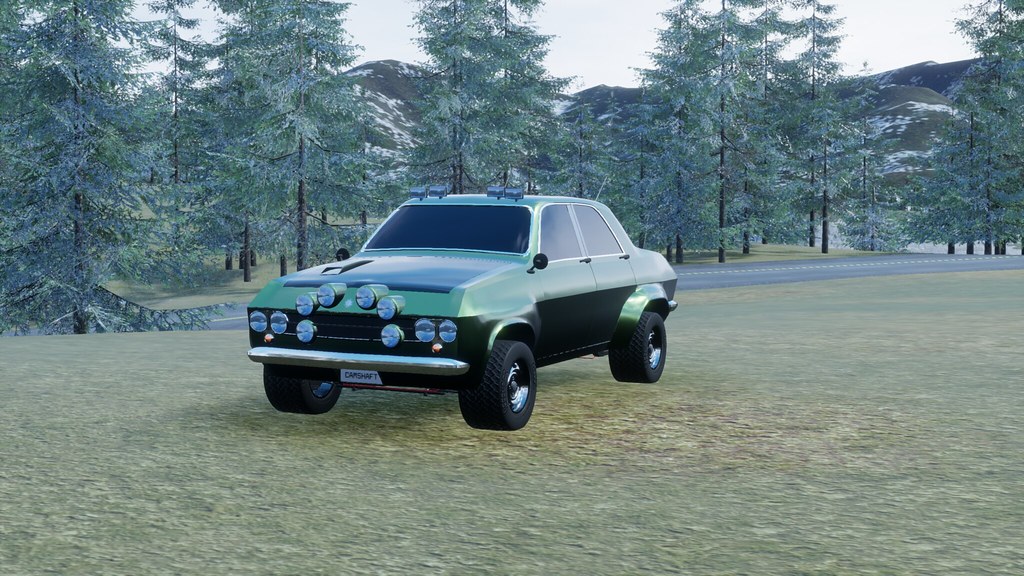Welcome to the first edition of the Great Archanian Trek
What is the Great Archanian Trek?
The great Archanian Trek is an offroad endurance rally open to amateur and professional drivers. The terrain is tough but not unpassable, so the race is open for slightly modified production vehicles. Rather than speed, durability and drivability will play a serious role in who finishes in the least time. For this first edition, 5 stages between ~200 and ~600 kilometer (~120 to 370 miles) are planned.
Method to roleplay races
A random selection of sectors (5-10) from different tracks (to be communciated) will be used to simulate a route / stage. The total time will be transposed to hours. For example, in a test race, 5 sectors gave me a time 5 minutes and 05 seconds. This becomes 5 hours and 5 minutes (“stage time”).
(Every car gets to do the same sectors, but when calculating distance, we role play this:)
The terrain we follow is very diverse, which means people can take different routes and their total distance per stage travelled can differ. We take your “stage time” mentioned above and take your average speed over this offroad route to calculate the distance you traveled. Your average speed over the tricky off-road stage will be the average speed of your car on Airfield Track divided by two.
Now to that “stage time” extra time can be added:
1. fuel consumption:
every car gets a 35 liter fuel tank, your vehicle carries additional fuel (and must be able to carry at least 400kg in terms of cargo). Every stop to refuel takes 5 minutes.
Fuel consumption is taken from the detail stats/fuel economy tab; the cruise tests + acceleration tests for the speed closest to your average speed.
2. mechanical issues:
After each sector a random throw 1-1000 is done to simulate mechnical issues. If your reliability is for example 60.0, every number from 1 to and including 600 means your car moves on to the next sector without losing time.
If the throw is higher, then you have a minor mechanical issue. You then throw again, if 600 or lower, you remain at minor mechanical issue. If higher, you get a significant mechanical issue. You then throw again, if 600 or lower, you remain at singificant mechanical issue. If higher, you get a catastrophic mechanical issue. You then throw again, if 600 or lower, you remain at catastrophic mechanical issue. If higher, you get a stranded in desert and probably dead I don’t know.
Minor mechanical issue: 15 minutes extra
Signifcant mechanical issue: 1 hour extra
Catastrophic mechanical issue: 3 hours extra
Probably dead: my condolences
This is like a card game within the same stage, meaning if in a sector you get a minor issue, it carries over to the next sector. If you role a bad dice there, you are immediately at significant mechnical issue.
For catastrophic and propbably dead carrying over, you get a saving throw (so you need to get two bad rolls in a row).
3. Drivability, calculated as drivability + offroad - every point of comfort under 15.
Only one roll here at the point of “stage time”, same methodology. If you roll higher than the number above, you get a 30 minute penalty because you had serious issues that stage (got stuck one or multiple times, evaded a camel and got in a ditch, etc…).
After every minor mechanical issue, a drivability check will also take place. This is to simulate that minor issues do not cause you to stop immediately but hamper your concentration and your handling. This may add another 30 minutes.
All the above penalties added to your “stage time” makes your “total time” for the stage.
The car
- UE4 obviously, mods allowed.
- All bodies types are allowed, as are all body, trim, engine and variant year, as long as it is no newer than 1966.
- Maximum 6 quality points can be used on the engine (+ or -) and maximum 6 quality points can be used on the chassis or trim (+ or -).
- You can roleplay whether you are an amateur (with a budget of $10000) or a professional (with a budget of $15000). No mark-up applied.
- Car needs 2 basic seats (driver and co-driver) and a basic radio (to simulate communication equipment - yeah, we do rescue you when you are stranded - don’t forget your antenna). The basic is required, the number is not a hard limit. Keep in mind you need space to haul provisions, spare tires and extra fuel, doesn’t matter if on the roof, the back, the sides, or where rear seats would be.
- Cars drive on 92RON (or less) leaded fuel.
- Carry capacity of over 400kg
- Offroad tires are obligatory.
- Don’t even bother showing up with anything less than 35 Offroad Value.
(Even a light rear engined sports car with offroad tires and rear coil springs does the job, or go big with a big offroad truck or pickup, or adapt a standard sedan or muscle car in your lore. Be creative!)
Competing
Introduce your car below, as well as your driver, co-driver and team (amateur or professional).
PM me the exported car file:
Car model: 1966Trek - Username.
Car trim: Name of the car.
Engine family: 1966Trek - Username.
Engine variant: Engine name/code.
Deadline for submissions: 7 May 2018, 8:00am CET
Some examples of the cars I aim for


And even:














